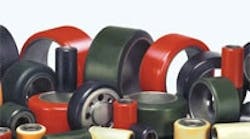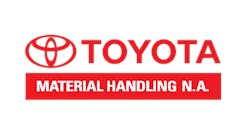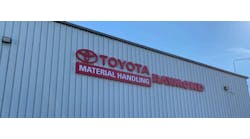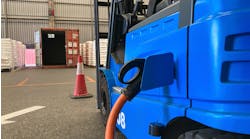Tires are all about compromise. A tire with exceptional mileage will not have the best traction. And, a tire that grips surfaces well will have a shorter life. There’s no such thing as a perfect tire with optimal tread life, traction and durability.
That’s why application is everything when it comes to tires. The secret to successful tire selection is fitting the tire to its intended use. Knowing which tire to use, when, can protect your vehicle investment, avoid costly downtime and keep operations running smoothly.
Unfortun-
ately, tires often rank at the bottom of the list of priorities for a material handling manager. They are one of the most overlooked components on a powered vehicle. Lift trucks, reach trucks, order pickers and other vehicles used in distribution centers and manufacturing facilities run relentlessly, ensuring the flow of product through the facility. The role of tires in this process is underestimated, and they are rarely, if ever, examined.
It seems the forgotten tire is only considered when there’s a problem, such as a puncture. Taking a more active look at the way tires are used in a facility can help prevent these costly problems in the first place.
The small industrial tire is the only source of cushioning and support for a lift truck and its loads. If a lift truck is equipped with the wrong tires for the application, the result is vehicle damage, reduced equipment life and increased maintenance costs.
When armed with knowledge about the type of tires available for specific applications and the science behind tire performance, material handling managers can protect their equipment investment and save money by replacing tires less often. The right tire for the right application will keep vehicles and materials moving.
Types of Tires
There are primarily three types of tires used in material handling applications: smooth, solid pressons (also called cushion tires); pneumatic-shaped solids; and pneumatics. Load wheels, also called outrigger wheels, stabilize the load on pallet trucks and reach trucks.
In the U.S., 70% of tires in material handling are press-ons, while the remaining 30% are pneumatic or solid, according to Joe Pauli, market manager at Continental Tire North America Inc. (Charlotte, N.C.)
Press-on tires, consisting of a metal ring with rubber or polyurethane bonded to it, are pressed onto lift truck rims with special equipment. They are available in either black rubber or non-marking varieties that are popular in clean environments, such as food processing and distribution facilities.
Pneumatic-shaped solid tires for material handling applications are also called ‘resilients,’ or ‘solid- shaped pneumatics.’ They are completely solid inside, while pneumatic tires are filled with air.
Each of these tire types is designed for a specific purpose. “Press-on tires only run indoors in warehouses or distribution centers,” says Ken Cooper, director of aftermarket sales at Trelleborg Wheel Systems (Hartville, Ohio). Trelleborg offers a standard-compound, press-on tire as well as a specific compound for electric material handling equipment.
“Misapplication of tires happens all the time,” says Pauli. “The most common misapplication is using a solid tire when a pneumatic tire should be used.” Pneumatic tires are best for large, gasoline or diesel lift trucks, such as those operating in lumber or construction yards that carry heavy loads. They work well outdoors and on rough surfaces.
Solid press-on tires are designed for use on Class I-IV lift trucks that operate on smooth floors at slow speeds, according to Pauli. “Press-ons are not for rough surfaces or high speeds (8-10 mph),” he says. “Pneumatic tires are more forgiving on equipment and can go at higher speeds.”
Pneumatic-shaped solid tires can be used both indoors and outdoors. However, they operate best on improved surfaces, such as asphalt or concrete, according to Gary Alcorn, co-owner of Teeler Industrial Tire, an industrial tire dealer in San Antonio. “They don’t wear as well when used on gravel and rocks,” he says.
Solid tires generally cost more than pneumatic tires; however, they tend to last longer. Most importantly, they eliminate downtime caused by flats and blowouts. “A solid tire will last three times longer than a pneumatic tire,” says Alcorn. “There are no flats, and keeping them inflated is not an issue.”
Science of Performance
In addition to understanding the types of tires used in material handling, knowing the basics about the science behind tire performance will also lead to more effective decisions. The performance of a tire is determined by its construction, exterior design and hardness.
Tires for material handling are constructed of either rubber or polyurethane. A rubber tire generally costs 25% to 50% less than a polyurethane tire, according to Reggie Collette, sales and marketing manager at Thombert Inc. (Newton, Iowa). However, it’s a smart move to select a polyurethane tire, despite the higher cost, in certain circumstances.
“Polyurethane is limited to electric lift trucks of various types that are used primarily indoors where the floors are made of smooth concrete,” says Collette. Trelleborg’s Cooper points out that polyurethane tires have three times more carrying capacity than rubber tires, making them ideal for vehicles that transport heavy loads.
“As a general rule, rubber tires are used more extensively on propane and internal combustion types of lift trucks,” says Collette. “These trucks often operate both inside and outdoors. In that type of application, rubber is preferred for a softer ride and better traction.”
Compared to rubber, polyurethane is harder, more durable and will last longer. “While rubber will offer a softer ride, it will not wear as well as polyurethane,” says Collette. “In fact, as a general rule, polyurethane tires will outlast rubber tires by about four times.”
Polyurethane tires are also more resistant to splitting, tearing or chunking out under load, Collette says. And, even though these tires come in a wide range of colors, polyurethane is inherently nonmarking.
Tread design—or the lack thereof—also affects tire performance. It may seem counterintuitive, but smooth tires provide more traction on dry floors than treaded tires, according to Alcorn. “More rubber touches the floor,” he says. “Especially with electric lift trucks, smooth tires provide better performance and last longer.”
Alcorn recommends replacing tires once they wear down to the sizing information printed on the sidewall. “A truck that runs on worn tires takes a beating,” he says. And, that eventually leads to higher vehicle maintenance and repair costs.
Treaded tires are ideal for outdoor applications, according to Michael North, vice president of marketing at Millennium Industrial Tire (Gardena, Calif.). “Tread conforms and grips on dirt and gravel,” he says. “However, tread will also provide more traction on a wet floor or in a freezer environment. It’s all about selecting the right tread and compound.”
On electric material handling vehicles in particular, rolling resistance— the energy a tire consumes as it rolls—is critical. The lower the rolling resistance of a tire, the less energy it needs to roll and the less drag on the battery. A tire with low rolling resistance will conserve battery life on an electric lift truck, resulting in fewer charges and increased productivity.
Rolling resistance is affected by a tire’s hardness, or ‘durometer.’ A tire with a low durometer is softer than one with a high durometer. A low-durometer tire will provide a softer ride for the operator and better traction. However, hard, smooth tires have better rolling resistance than those made with soft compounds. Because polyurethane tires are harder than rubber tires, they offer better rolling resistance.
A tire’s construction and durometer also affect its ability to withstand heat. Excessive internal heat buildup—a tire’s worst enemy— leads to premature wear and even tire failure. Heavy loads, long distances and high speeds all generate heat within a tire. Tires with high durometers can withstand heat more effectively than those with low durometers.
“Hysteresis is the internal heat buildup that results when a tire is cycling under a load, compressing the material as it touches the ground,” explains North. He says the process is similar to bending a paper clip back and forth repeatedly. The paper clip will eventually break from internal friction.
Though tire manufacturers offer compounds in a wide range of durometers to fit nearly every application, Thombert’s Collette says there is a move in the warehousing industry toward selecting more high-durometer compounds. “Speeds have increased,” he says. “Trucks used to go about three to four miles per hour. Now, they are going eight miles per hour or more.”
In addition, as loads have increased in weight, high-durometer tires have become more vital. Selecting low-durometer tires and load wheels for heavy-load applications, for example, will sacrifice load capacity as well as cut and tear strength, says Collette.
“If there’s a need to carry extremely heavy loads, long distances are traveled, or order pickers are running at higher speeds, there’s a need for a tire with increased heat resistance,” North says. Polyurethane is not as efficient as rubber at releasing heat, according to North. “Rubber is a lower-performance material,” he adds, “but it releases heat.”
However, North says Millennium Industrial Tire offers specific polyurethane compounds that increase heat resistance. “We offer standard polyurethane compounds, a Hyload compound and also a Megaload compound,” says North. The company’s Megaload compound offers dramatically increased performance and heat resistance in heavy-load conditions, according to North. He says it can carry up to 25% more weight than standard compounds.
“A softer polyurethane compound will result in a smoother ride,” North says. “However, it also reduces rebound and drains the battery.” That led Millennium Industrial Tire to develop its SPS low-durometer compound. According to North, SPS offers the low-durometer cushion of a soft tire while maintaining the equivalent rebound of a high-performance, high-load compound. SPS is suitable for vehicles that operate on loading docks and rough floors and in harsh freezer applications.
Thombert offers a ‘good-betterbest’ lineup of press-on tires and load wheels in three different polyurethane compounds with three durometers. Typically, load wheels are available in durometers ranging from 83 to 95, says Collette.
Dyalon B, with a durometer of 83, is Thombert’s ‘good’ main workhorse compound, designed for use on vehicles operating at loading docks, in cold storage and freezers and on rough floors. Dyalon A, the ‘better’ product, is harder, with a 95 durometer. Dyalon A is designed for heavy load, long-run applications and high-stress order picking and transporting. “We see more applications requiring that heavierduty compound,” Collette says, “especially on reach truck wheels and wheels that go under 96-inch forks, where you see maxxed out use.”
Thombert offers a third option, the 93-durometer Vulkollan, classified as the company’s ‘best.’ Collette says that, even though the durometer of Vulkollan is lower than the mid-range Dyalon A, Vulkollan is designed with a completely different polyurethane compound that resists heat and has an extremely high load-carrying capacity. Designed for extreme overload conditions and very long runs at high speeds with full loads, Collette says he would recommend Vulkollan to a warehouse manager who had been running trucks on Dyalon A yet still fighting premature wheel failure because of heavy loads and long runs.
Weighing Tradeoffs
As stated earlier, tires are all about compromise, and a material handling manager should consider which tire attributes are most important for each application. Operating environment, power source, speed and load requirements are all factors that must be considered in the tire selection equation.
“A solid tire lasts about 40% longer than a pneumatic,” says Pauli. However, there’s a tradeoff: A pneumatic tire offers a more comfortable ride, while a solid tire is harder on the vehicle and the operator. And, a rougher ride could damage delicate loads, especially on unimproved surfaces and damaged floors.
Although pneumatic tires are better than solid tires at absorbing shock and gripping rough surfaces, they bring with them the risk of flats from punctures. Material handling managers can eliminate the risk of downtime caused by flats by using press-on tires and solids. However, these tires, too, have drawbacks, one of which is the need for special mounting equipment.
“You need a specific press to change press-ons or pneumaticshaped solids, so it’s easier to change pneumatic tires,” says Pauli. Fortunately, many tire dealers offer mobile press trucks to change these tires for customers. Still, tire users must weigh the pros and cons carefully and consider the environment in which vehicles operate. In very damaging environments, for example, it’s better to absorb the cost and time of changing solid tires because of the risk of flats, says Pauli.
A year ago, Continental introduced its CSEasy tire as a replacement for pneumatic-shaped solids. The advantage of CSEasy: No press or special equipment is required. This tire can be fitted on site, ensuring the lift truck is back in operation within minutes, according to Continental. “Customers can change the tire with only a wrench and a jack,” says Pauli. Currently, the CSEasy is approved for use on the European brand lift trucks Jungheinrich, Linde and Still.
In pneumatic tires, air pressure must be checked regularly. Underinflated tires reduce rolling resistance, undermine fuel economy and wear out much faster than those kept at the tire manufacturer’s recommended air pressures.
Alcorn says underinflation is a problem he sees far too often when visiting customers. “Improper inflation leads to premature wear,” he says. “When operators do their vehicle maintenance checks, tires are often overlooked.”
To get the benefits of both a pneumatic- shaped solid and a pneumatic tire, industrial tire users will sometimes have them filled with a flatproofing material that completely fills the air cavity, eliminating both the risk of flats and the need for air-pressure checks.
Bob Giasson, director of original equipment sales and marketing at Arnco (South Gate, Calif.), a tire flatproofing company, explains that his polyurethane and foam-fill tire liners are used predominantly in tires on rough-terrain lift trucks, telehandlers and other outdoor material handling equipment.
Though the main purpose of flatproofing is to eliminate the risk of flat tires, there are other reasons Giasson’s customers ask for the tire fill. “Some customers prefer a firmer ride than a standard pneumatic tire,” Giasson says. “They want less deflection in the tire to cut down on the bounce.” Arnco offers tire fill in a range of durometers so that customers can customize ride quality.
Cost of Operation
“As manufacturers have had more demands put on them with ever-larger warehouses and everlarger tonnage moving through those warehouses, lift truck manufacturers, lift truck dealers and end users realize that it is the cost per hour of operation that is really important,” says Collette.
In other words, spending a little more upfront on the right tire will save money in the long run by reducing the risk of costly downtime and maintenance. “It takes about 15 to 25 minutes to change wheels,” says Collette. “And, the overhead rate in warehouses these days is running $85 to $90 an hour.”
In addition, a high-quality tire will ride better and preserve the life of a vehicle, says Trelleborg’s Cooper. “Companies will save money in the long term with a quality tire,” he says.
Collette agrees. “When the right compound is used, it’s common to get an additional 35% to 40% performance out of that correct product,” he says.
While the science of tires is far from simple, the end result of choosing the right tire is not complex. The perfect fit will save money, reduce frustration and keep those vehicles moving.



